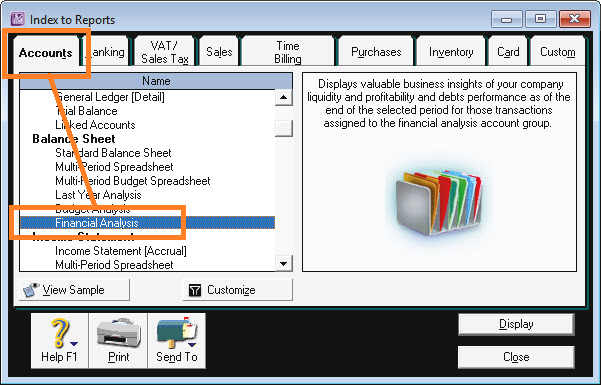ABSS financial analysis report
With the release of ABSS Accounting v28.3 and ABSS Premier v23.3, ABSS included a financial analysis report.
This report helps business owners understand how their business is performing and identify areas that would need improving.
Before you can start using this report, you will need to set it up within your company file.
Edit account details
To use this report, you need to link the relevant accounts to respective categories used in ratio analysis.
This can be done by selecting the ‘Financial Analysis acc group’ in Edit Accounts, Details tab.
You can select financial analysis account group from the dropdown list.
To understand which category requires mapping, see the formulas below, or you can also refer to the formula stated in the report, and map your accounts accordingly to get desired result.
There are three types of analysis provided in this report:
Liquidity Ratios
Cash Ratio
A liquidity ratio that measures a company’s ability to pay off its current liabilities with only cash and cash equivalents.
Formula: Cash + Cash Equivalents divided by Current Liabilities
Current Ratio
A liquidity and efficiency ratio that measures a company’s ability to pay off its short-term liabilities with its existing assets.
Formula: Current Assets divided by Current Liabilities
Gearing Ratio
A performance ratio that shows the proportion of finance that is provided by debt relative to the finance provided by equity.
Formula: Long-term Liabilities divided by Capital Employed
Performance Ratios
Interest Coverage
A performance ratio that measures the company’s ability to meet its interest payments.
Formula: EBITA divided by Interest Expense
Return On Capital Employed % (ROCE)
A profitability ratio that measures the returns that a company is
achieving from the capital employed.
Formula: EBITA divided by Capital Employed x 100
Profitability Ratios
Return On Sales %
A profitability ratio that calculates how efficiently a company is at
generating profits from its revenue.
Formula: EBITA divided by Income x 100
Gross Profit Margin %
A profitability ratio that measures how efficiently a company uses
its cost of goods sold to produce and sell products profitably.
Formula: Income – Cost of Goods Sold divided by Income x 100
Printing the report
You can access the report by going to Reports, Accounts, and you will find it under the Balance Sheet heading as shown below:
Definition of terms
Capital Employed and EBITA are defined as:
Capital Employed = Long Term Liabilities + Shareholders Equity + Retained Earnings + Current Earnings
EBITA = Net Profit + Interest Expenses + Tax Expenses
EBITA stands for Earnings Before Interest, Taxes and Amortization.


